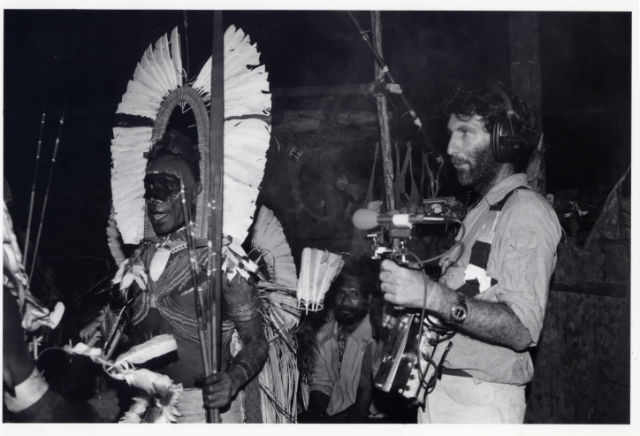Voices of the Rainforest is a recorded soundscape of a day in the life of the Kaluli people of Bosavi, Papua New Guinea. As the day progresses, one hears birds, water, insects and other ambient voices of the rainforest interspersed with Kaluli songs and instrumental sounds of work, leisure and ritual. The album was recorded with Mickey Hart’s advanced field recording gear by anthropologist and ethnomusicologist Dr. Steven Feld. Feld’s closeness to the Kaluli people afforded him a unique recording opportunity, and the quality of the recording equipment yielded among the clearest aural experiences of the rainforest short of being there. For further information about the community that created this music, visit the Bosavi Peoples Fund website. Voices of the Rainforest was issued in 1991 as part of “THE WORLD” series (now part of the Mickey Hart Collection made available by Smithsonian Folkways)
— from the Smithsonian Folkways Website
Here’s the Anthropologist Steven Feld writing about his work.
What role can an anthropological voice have in this large mix we’re calling acoustic ecology and soundscape studies? How is this voice complementary to, yet distinct from, voices from history, acoustics, performance, design, psychology, geography, musicology, composition, architecture, philosophy, or communications? One way to answer is with the simple observation that anthropologists tend toward the Kantian view that all knowledge begins in experience. We jump off that cliff to study how human experiential patterns and practices construct the habits, systems of belief, knowledge, and action we call culture. And we study it everywhere and anywhere we can. Our ultimate concern is with people, with adequately and evocatively representing their experiential worlds, their voices, their humanity. To take up that concern the anthropological project basically must ask, what could it possibly be like to be – to feel, sense, imagine, act, become – another kind of person? A full answer, of course, is an impossibility. We cannot become another. But the challenge of getting close or at least closer, of glimpsing, hearing, touching other realities, is thoroughly compelling to us. Another way to say it is that what turns us on is human complexity and diversity, and we celebrate and document it all, from beauty and hope to horror and despair. In fact we tend to do this in far more detail and with far more obsession than the general public cares to know about. We justify what others perceive as our excess by claiming, simply, that there is too much we don’t know about the sources and varieties of human difference. But deep down we hope that by writing and circulating other peoples’ histories, by giving their voices places to speak and shout and sing from, we in some measure combat and counter the longstanding arrogance of colonial and imperial authority, of history written in one language, in one voice, as one narrative.
and on The role of editing and mixing:
I think that the best thing I can do, either with two channel recordings, or with studio mixing techniques, or a combination of the two, is to transport the listener into what is distinctive about the Bosavi sound world and the way I have learned to listen to it. Inevitably this means that I must heighten or amplify or bring out certain subtleties and nuances of the ways the forest sounds so that they are more present and available to novice listeners. I have to take this auditory slippage and retune the recordings to bring out their “lift-up-over sounding.” But of course there is nothing new about this; artists in cultures everywhere have been practicing such “selective amplification” of everyday life for centuries.
— more here
